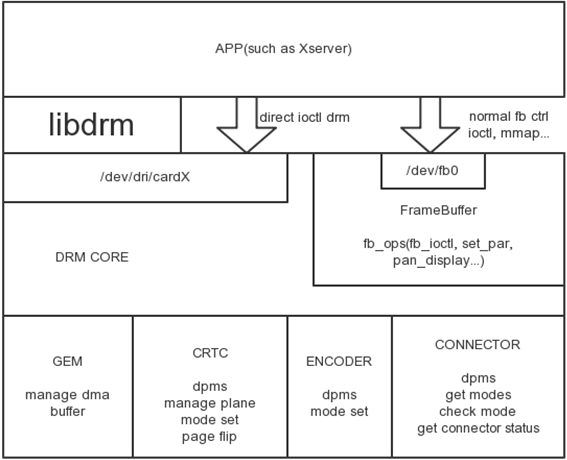“Linux Display study”的版本间的差异
来自个人维基
free6d1823(讨论 | 贡献) |
free6d1823(讨论 | 贡献) |
||
| 第9行: | 第9行: | ||
graphic stack alternatives such as Wayland. | graphic stack alternatives such as Wayland. | ||
| − | Ap -> [DRM API] -> libDrm -> [ioctls ]-> | + | Ap -> [DRM API] -> libDrm -> [ioctls ]-> DRM driver |
libDrm: | libDrm: | ||
vblank event handling, | vblank event handling, | ||
| 第19行: | 第19行: | ||
DMA services. | DMA services. | ||
| + | DRM driver: | ||
| + | drm_driver structure | ||
| + | u32 driver_features; //use AGP,use GEM mem manager, support KMS interfaces, DRM prime buffer sharing, | ||
| + | int (*load) (struct drm_device *, unsigned long flags); //driver and device initialization entry point. | ||
https://blog.csdn.net/yangkuanqaz85988/article/details/48689521 | https://blog.csdn.net/yangkuanqaz85988/article/details/48689521 | ||
DRM | DRM | ||
[[image:DRM.png]] | [[image:DRM.png]] | ||
2019年11月1日 (五) 11:35的版本
The Direct Rendering Manager (DRM) is a subsystem of the Linux kernel responsible for
interfacing with GPUs of modern video cards. DRM exposes an API that user space programs
can use to send commands and data to the GPU, and perform operations such as configuring
the mode setting of the display. DRM was first developed as the kernel space component of
the X Server's Direct Rendering Infrastructure, but since then it has been used by other
graphic stack alternatives such as Wayland.
Ap -> [DRM API] -> libDrm -> [ioctls ]-> DRM driver
libDrm:
vblank event handling, memory management, output management, framebuffer management, command submission & fencing, suspend/resume support, DMA services.
DRM driver:
drm_driver structure
u32 driver_features; //use AGP,use GEM mem manager, support KMS interfaces, DRM prime buffer sharing, int (*load) (struct drm_device *, unsigned long flags); //driver and device initialization entry point.
https://blog.csdn.net/yangkuanqaz85988/article/details/48689521
DRM
